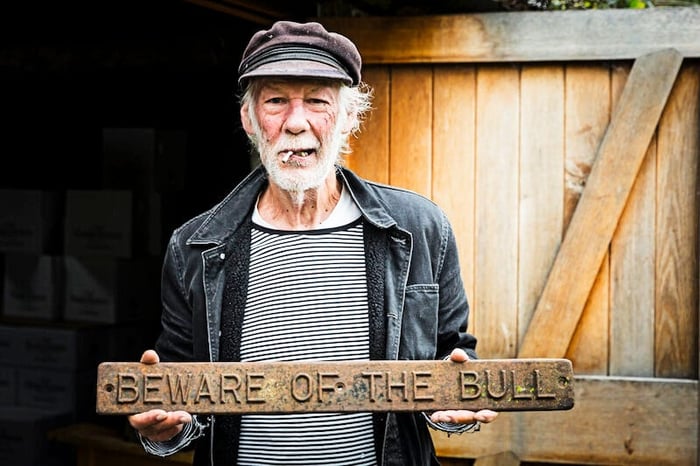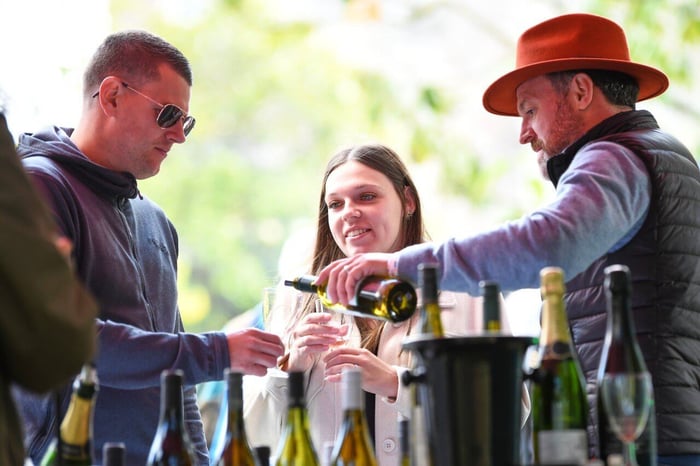
Breaky Bottom, the pioneering English vineyard, turns 50!
There could only be one wine to celebrate the coronation of King Charles III in May 2022: Breaky Bottom. It’s not only the most distinctly English of all sparkling wines but one that’s a great favourite of the King and Queen consort. The one I opened was particularly special: Cuvée Koizumi Yakumo 2010. It’s made from a much-maligned variety Seyval Blanc but somehow the winemaker Peter Hall manages to coax the most extraordinary flavours of orchard fruit, spices and croissants from it.
Buy Breaky Bottom wines online
This year Hall celebrates 50 years at Breaky Bottom in Sussex. These days he’s feted by royalty, lionised by the wine press here and abroad, listed by fashionable restaurants and prestigious wine merchants and in 2021 Hugh Johnson picked a Breaky Bottom wine as one of his top ten wines in the world.
It was a very different world when Peter started.
He was a tenant farmer with a small holding in Sussex keeping pigs and sheep. In 1974, the year his youngest son Toby was born, he decided to plant some vines after discovering Nick Poulter’s books about growing grapes on the Isle of Wight.
Peter had no practical experience but had picked up a love of wine from his French mother. There was no Plumpton College (the celebrated agricultural college teaching viticulture to future british winemakers) to show him what to do, just various isolated pioneers like Poulter who visited Breaky Bottom and agreed it would be a good place to grows grapes.

Peter planted Seyval Blanc and Müller-Thurgau. The first vintage was 1976. Without the money for proper winemaking equipment he took the grapes to the best-equipped vineyard in the country Lamberhurst in Kent run by Kenneth McAlpine, who died last year at 101. The winemaker Karl-Heinz Johner had trained at Germany’s elite wine school at Geisenheim.
What could possibly go wrong?
Well, according to Peter putting on an amusing German accent, Johner admitted that despite all his learning, this was his first commercial vintage. “He completely goofed it up,” Peter explained. Johner had added water and sugar to Peter’s high quality grapes to make an approximation of Liebfraumilch when Peter wanted a dry French-style wine. It took years but eventually Peter got compensation for those ruined grapes.

This wasn’t the only trial that Peter and his first wife Diana faced.
Five times their cottage was flooded out by water run-off from a neigbour’s field and they were reduced to living in a caravan. Another year there was a plague of pheasants which ate all the grapes. Peter didn’t take this lying down and eventually got compensation for this too.
He clearly relishes a fight.
Most of all, Peter fought what he called the BAW (Bloody Awful Weather) years, a run of soggy vintages from the ‘70s until the late ‘80s when the warmer harvests became more frequent.
You can get a vivid picture of those days from looking at the Breaky Bottom website. There’s Peter working with astonishingly rudimentary equipment, second hand fibreglass tanks and a hundred year old cast iron wine press, or surrounded by pigs, sheep and children, always with a fag in his mouth.
Once Peter took over winemaking in 1977, he began making what he modestly describes as “tolerably acceptable wine.” Slowly people began to notice that there was something special going on in this six acre vineyard in an isolated corner of Sussex. Oz Clarke and Andrew Jefford were early champions. An experimental planting of Melon de Bourgogne and Sauvignon Blanc was, however, not a success. “Bloody awful! Not enough sugar”, according to Peter.

From making still wines, Hall switched to sparkling wines in the 1990s, pulled out the Müller-Thurgau to be replaced with Chardonnay and Pinot Noir. But he held faith with the Seyval Blanc, crafting wines that have become - like Peter - legendary.
When people ask me the highlight of researching my book about English wine, it has to be a visit to Breaky Bottom. There's the long trek over an unmade road that felt like it was going to shake my old car to pieces - one that apparently gets worse every year. And just when I was about to give up hope, there’s a little valley with vines growing up the sides and a farmhouse at the bottom. Despite being only a few miles from Brighton, it feels like you have discovered a lost arcadia, cut off from the 20th century, something accentuated by Peter himself. He looks like a cross between an ageing rock star and the ancient mariner, his lined face perpetually wreathed in cigarette smoke.

When I visited he was recovering from a damaged achilles tendon but still working “eight days a week” in the vineyard. He’s helped by one more or less permanent helper Louisa Adams with Emma Rice formerly of Hattingley Valley also involved. Come harvest time, figures such as Dermot Sugrue, Stephen Skelton and Johnny Ray lend a hand.
Talking to Peter, he sounds like he’ll go on for another 50 years but his second wife is not well which is taking its toll. With six children between him and Christine, none of whom are interested in winemaking, Peter isn’t sure what will happen to Breaky Bottom when he’s gone. He’s already turned down a seven figure offer from a buyer from the Low Countries.
I get the impression that Peter wants to carry on making wine for as long as he can and not think too much about the future. He’s reluctant to leave the vineyard or indeed receive visitors - he only agreed to see me when Stephen Skelton put in a good word. So the best way to get to know Breaky Bottom is through the wines. Like their maker, there’s nothing quite like them.




